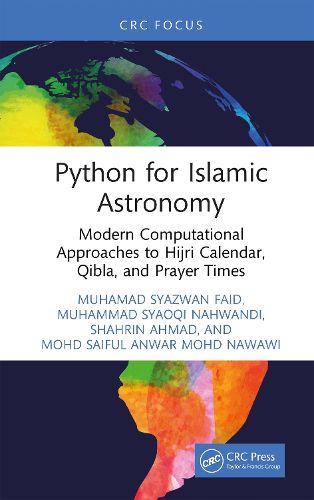Readings Newsletter
Become a Readings Member to make your shopping experience even easier.
Sign in or sign up for free!
You’re not far away from qualifying for FREE standard shipping within Australia
You’ve qualified for FREE standard shipping within Australia
The cart is loading…






Python for Islamic Astronomy: Modern Computational Approaches to Hijri Calendar, Qibla, and Prayer Times responds to the urgent need to improve calculation accuracy and data visualizations in the field of Islamic Astronomy. This field is becoming increasingly complex, leading to mistakes in determining the beginning of the Hijri month, Qibla directions, and prayer times. This book offers a more precise approach by showing how the Python environment can be tailored for astronomical computations and how the mathematical principles behind Qiblah determination can be implemented through elegant Python algorithms. The guide provides detailed methodologies for calculating prayer times with astronomical precision, allowing for accurate scheduling regardless of global location. The book also delves into the science of moonsighting, helping readers learn to compute and analyze observation data critical for Islamic calendar determinations. Advanced visualization chapters bring these calculations to life through practical applications: develop your own Qiblah compass, create visual representations of the sun's position during prayer times, and generate detailed lunar crescent visibility charts to aid in moon-sighting efforts. Perfect for programmers interested in Islamic Astronomy, religious scholars embracing technology, or anyone seeking to understand the mathematical foundations behind these traditional practices, this guide bridges ancient wisdom with modern computational techniques, making complex astronomical calculations accessible through the power of Python.
Key Features:
The first book to provide practical guidance for using Python, supplemented by an interactive coding website, to solve real-world problems in the field of Islamic Astronomy. Uses the latest and most-trusted methods in Islamic Astronomy, ensuring all calculations are accurate and based on well-recognized references. Includes visualizations that help readers understand key topics like Qibla direction, prayer time zones, and lunar crescent visibility, making the content practical and user-friendly.
$9.00 standard shipping within Australia
FREE standard shipping within Australia for orders over $100.00
Express & International shipping calculated at checkout
Stock availability can be subject to change without notice. We recommend calling the shop or contacting our online team to check availability of low stock items. Please see our Shopping Online page for more details.
Python for Islamic Astronomy: Modern Computational Approaches to Hijri Calendar, Qibla, and Prayer Times responds to the urgent need to improve calculation accuracy and data visualizations in the field of Islamic Astronomy. This field is becoming increasingly complex, leading to mistakes in determining the beginning of the Hijri month, Qibla directions, and prayer times. This book offers a more precise approach by showing how the Python environment can be tailored for astronomical computations and how the mathematical principles behind Qiblah determination can be implemented through elegant Python algorithms. The guide provides detailed methodologies for calculating prayer times with astronomical precision, allowing for accurate scheduling regardless of global location. The book also delves into the science of moonsighting, helping readers learn to compute and analyze observation data critical for Islamic calendar determinations. Advanced visualization chapters bring these calculations to life through practical applications: develop your own Qiblah compass, create visual representations of the sun's position during prayer times, and generate detailed lunar crescent visibility charts to aid in moon-sighting efforts. Perfect for programmers interested in Islamic Astronomy, religious scholars embracing technology, or anyone seeking to understand the mathematical foundations behind these traditional practices, this guide bridges ancient wisdom with modern computational techniques, making complex astronomical calculations accessible through the power of Python.
Key Features:
The first book to provide practical guidance for using Python, supplemented by an interactive coding website, to solve real-world problems in the field of Islamic Astronomy. Uses the latest and most-trusted methods in Islamic Astronomy, ensuring all calculations are accurate and based on well-recognized references. Includes visualizations that help readers understand key topics like Qibla direction, prayer time zones, and lunar crescent visibility, making the content practical and user-friendly.